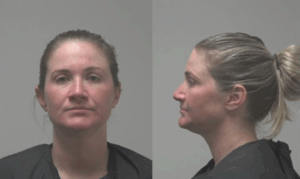For the past six months the Coweta County Sheriff’s Office has been using body cameras for road deputies and in the jail and for investigations. The benefit to both citizens and law enforcement has met and exceeded expectations.
“There is an advantage for citizens and officers. The camera records the incident as it happened. It’s an extra step of protection for citizens and it helps the officer and the whole judicial system because it speaks the truth,” said Maj. Tony Grant with the sheriff’s Office of Professional Standards. “When the cameras first rolled out some officers were skeptical… of ‘big brother.’ But the camera sees and hears everything. Now after six months of use, the officers love them.”
The Taser Axon Flex camera can be worn on a headband or attached to glasses, though most deputies are wearing the headband, said Grant. Another type of Taser Axon, used by jailers and investigators, is worn on the shirt in the chest area. The cost of the Flex is approximately $350 per unit while the shirt-mounted camera costs in the range of $300.
Grant said the sheriff’s office began testing the camera units in 2013 with both detectives and road deputies and eventually decided on the Taser Axon Flex. An initial purchase of 106 units was made and were put into operation in June 2014, Grant said.
“The camera’s durability was a step above the rest (of the cameras tested),” said Grant.
Grant said the main reason to go to the new camera system involved officers discharging their firearms.
“The camera is at eye-level and records at eye-level,” Grant said, explaining yet another use for the head-mounted camera, one that is superior to the limited view provided by the camera in the patrol vehicle. “You can see an incident even when you’re driving down the road.”
Grant said there was an initial concern that the camera might not stay positioned on the deputy’s head during an altercation or a chase. Yet the versatility of the camera was clear during a recording of an incident where deputies had to chase a man through a wooded area. Though they chased the man for some distance, the camera captured the chase from beginning to end.
“The camera is automatically running all the time. Once you hit the record button is goes back 30 seconds and begins recording,” Grant explained, adding that the camera fully charged can record for eight hours before the video must be downloaded.
As for its use in court cases, Grant said the the digital recordings are being accepted in the county’s magistrate, state and superior courts.
Prior to the days of the new body cameras the sheriff’s office used to sometimes get citizen complaints from traffic stops where the person would ask to have the charges dropped. With the body cameras now deployed the complaints about use of force and officer rudeness have dropped off tremendously, Grant said.
“When someone calls we tell them we’ll review the video or they can come in and review the video with us,” Grant said. “They sometimes say ‘what video’ then they say ‘never mind.’”
When it comes to retaining digital data, Grant said the sheriff’s office usually retains it for 30 days depending on the category of the call or incident involved. Data involving serious crimes such as murder can be retained indefinitely while incidents such as DUIs may be kept for 3-5 years. Smaller infractions with no criminal actions are deleted after 30 days, Grant said.
Grant noted that there may be instances where a portion of a data recording contains compromising video of a personal nature that does not involve the call or the incident, such as a person at a residence being partially clad. Explaining the procedure used to prevent that type of exposure from being seen by the public via a Ga. Open Records request, Grant said there are two measures that can be taken.
One measure is to have two administrators sign off on deleting that portion of the video prior to the 30-day period before lesser “no action” videos would be deleted. The second option would be to have the personally compromising portion of the video technically “blurred out” so that the portion of the video showing, for example, a person only partially clad, would not be recognizable, Grant said.
The sheriff’s office, as part of the $400,000 purchase and data storage contract agreement that extends over five years, will have all 106 cameras replaced at no charge in 2016 and again in 2018. Grant noted that the significant majority of the costs is associated with data storage.
“It’s one thing to have a camera. It’s another thing to have the data stored effectively and retrievable,” he said.












Leave a Comment
You must be logged in to post a comment.